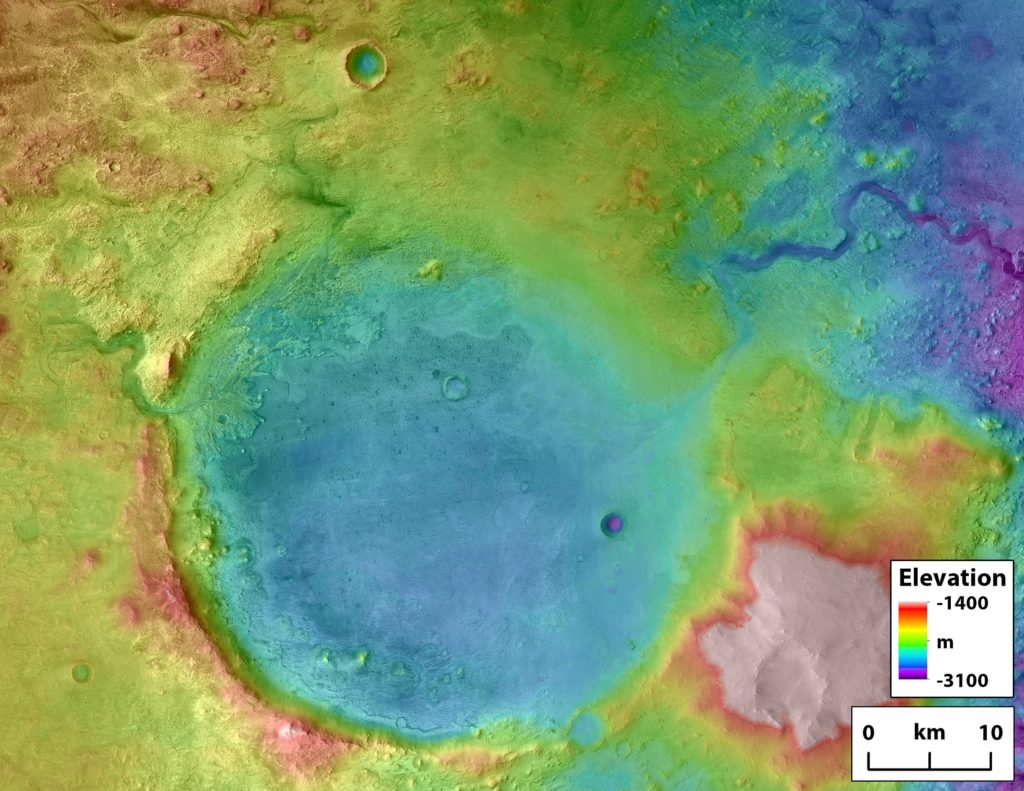Featured image: Artist depiction of the Mars 2020 Perseverance Rover on Mars. Public domain (NASA/JPL-Caltech).
Authors: Nicolas Mangold, Gilles Dromart, Veronique Ansan, Francesco Salese, Maarten G. Kleinhans, Marion Masse, Cathy Quantin-Nataf, and Kathryn M. Stack.
On Mars, we see a very different landscape to that on Earth. Although now an arid planet, great scars visible from space – such as the colossal Valles Marineris, which dwarfs Earth’s Grand Canyon – hint at a once watery world. But scientists still aren’t sure whether water on Mars might once have hosted life. On the 30th of July, NASA will launch the Mars 2020 mission, which will gather clues about the planet’s past and seek signs of ancient life on Mars. An essential part of such a space mission is extensive planning, so that scientists can target the most important rocks for study and sampling when the rover gets to Mars. A recent study by Nicolas Mangold and colleagues did just that by looking closely at the landing site for this next Mars mission, known as Jezero crater.
Jezero crater is the site of what planetary scientists think was once a lake, and contains two fan-delta deposits (where flowing water once hit a standing body of water). These fan-delta deposits are particularly exciting for planetary scientists because the sediments might preserve evidence of past life. The study lead by Nicolas Mangold from the University of Nantes in France uses images taken by the European Space Agency’s (ESA) Mars Express mission and NASA’s Mars Reconnaissance Orbiter to conduct a detailed investigation of the channels that once flowed into the Jezero crater lake and make estimations of how much water once flowed through them. The Mars 2020 mission, which contains the Perseverance Rover and Ingenuity helicopter, is the first mission in a planned ‘Mars Sample Return’ campaign, a joint venture between NASA and ESA. The investigation of the channels by Mangold and colleagues allowed them to make valuable suggestions as to which sediment deposits might be of most interest for the Perseverance rover to collect.
There are two main inlet channels into the crater: Neretva Vallis to the West, and an unnamed valley to the North. In their study, Mangold and co-authors used techniques that will be familiar to those who study the landscapes of Earth, such as looking for landforms called fluvial bars (sediment deposited by flowing water). They also scrutinised the level of erosion of visible channels, which involves deciding whether the features look sharp and pristine or somewhat muted. Finally, the authors estimated the amounts and speeds of water flow, taking into account Mars’ gravity, which is roughly a third that of Earth’s.

A false colour image of Jezero crater on Mars, the landing site for the NASA Mars 2020 mission. Public domain (NASA/Tim Goudge).
Their results suggest that two distinct episodes of water activity formed the valleys. The western section of Neretva Vallis was likely formed first, whereas the eastern part of Neretva Vallis, as well as the valley to the North, were formed later. The authors think that in this second stage, the water might have flowed more rapidly, which means it would have transported more coarsely-grained (bigger) material. This second flow of water could also have occurred slightly more recently than previously estimated, although still at least 3.2 billion years ago, in a geological period of Mars known as the ‘Hesperian’.
What does this mean for the Mars 2020 mission? The key goal of the mission is to determine whether life ever arose on the Red Planet. Scientists know that the biological signatures of life can be well preserved in fine-grained sedimentary deposits such as clays. This indicated to the authors that the most recent, more coarsely-grained sediments at the top of the fan deposit, might not be the best target for Perseverance. Instead, the fine-grained deposits at the bottom of the fan delta, which could have transported signatures of life from the first episode of water flow, may actually be the best candidates for preserving the evidence of life the mission is looking for.
Once the Perseverance rover touches down in Jezero crater and starts examining the sediments, scientists will be able to start looking at the size of the rocks and get a better idea of which samples are the most important to cache for a future return to Earth. Studies like this one are essential to planetary science because they let us target the right places to take samples from so that scientists can use the mission’s limited time more efficiently. And that’s important for the Mars 2020 mission because, just like the rocks on Earth, the rocks on Mars are a history waiting to be told.

Looking for life on Mars: what can the valleys that once flowed into Jezero crater tell us about the best rocks to sample? by Eleni Ravanis is licensed under a Creative Commons Attribution-ShareAlike 4.0 International License.

